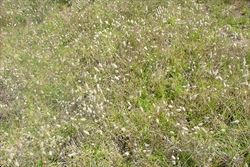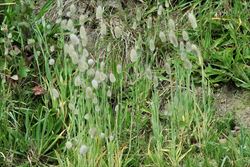Click on images to enlarge

large infestation of mature plants (Photo: Sheldon Navie)

infestation (Photo: Rob and Fiona Richardson)

habit (Photo: Rob and Fiona Richardson)

leaves and young seed-heads (Photo: Rob and Fiona Richardson)

close-up of feathery seed-heads in flower (Photo: Rob and Fiona Richardson)

mature seed-heads (Photo: Sheldon Navie)

close-up of very hairy mature flower spikelets (Photo: Sheldon Navie)

a native hedgehog grass (Echinopogon sp.) seed-head, without hairs on its flower spikelets (Photo: Sheldon Navie)
Scientific Name
Lagurus ovatus L.
Family
Gramineae (South Australia)Poaceae (Queensland, New South Wales, the ACT, Victoria, Tasmania, Western Australia and the Northern Territory)
Common Names
hare's tail, hare's tail grass, hare's-tail, harestail, hare's-tail grass, harestail grass
Origin
Native to northern Africa (i.e. Algeria, Egypt, Libya, Morocco and Tunisia), the Azores, the Madeira Islands, the Canary Islands, southern Europe (i.e. France, Portugal, Spain, Albania, Bulgaria, Greece, Italy, Yugoslavia and Ukraine) and western Asia.
Cultivation
This species is thought to have become naturalised after escaping from cultivation as an ornamental grass.
Naturalised Distribution
Widely naturalised in southern and eastern Australia, particularly in coastal districts. It is common in the coastal districts of central and southern New South Wales, in Victoria and Tasmania, in southern South Australia and in south-western Western Australia. Occasionally naturalised in southern and central Queensland, in inland New South Wales, in south-eastern Western Australia and on Lord Howe Island. It was also naturalised in the ACT, but has not been recorded there for some period of time.
Also widely naturalised in many other temperate regions of the world, including the UK, southern Africa, New Zealand, parts of North America and southern South America.
Habitat
A weed of dry coastal vegetation, grasslands, grassy woodlands, roadsides, disturbed sites, waste areas and wetlands in the temperate region of Australia.
Habit
A relatively small, short-lived (i.e. annual), grass usually growing 5-50 cm tall, but occasionally reaching up to 0.6 m in height.
Distinguishing Features
-
a relatively small, short-lived, grass usually growing 5-50 cm tall.
-
its softly hairy leaves are tufted at the base of the plant and alternately arranged along the stems.
-
its slender upright flowering stems are topped with an egg-shaped or slightly elongated seed-head (1-6 cm long and 1-2 cm wide).
-
these whitish seed-heads are feathery in appearance and usually persist for several months after flowering.
Stems and Leaves
The upright (i.e. erect) flowering stems (i.e. culms) are slender.
The leaves consist of a leaf sheath, which partially encloses the stem, and a leaf spreading blade. These leaves are tufted at the base of the plant and alternately arranged along the stems. The leaf sheaths are hairy (i.e. pubescent) and where the leaf sheath meets the leaf blade there is a small membranous structure (about 2 mm long) topped with tiny hairs (i.e. ciliated membranous ligule). The leaf blades are flat (up to 20 cm long and 1.5 cm wide) and are covered with short hairs (i.e. pubescent).
Flowers and Fruit
The spike-like seed-head (i.e. spiciform inflorescence) is a short, dense, cluster of flower spikelets. These whitish-coloured seed-heads (1-6 cm long and 1-2 cm wide) are egg-shaped (i.e. ovoid) or slightly elongated in shape. Each of the narrow flower spikelet (8-10 mm long) consists of a pair of bracts (i.e. glumes) and a single tiny flower (i.e. floret). The bracts (about 5 mm long) are topped with a short awn (about 5 mm long) that is covered in long hairs, giving it a very feathery appearance (i.e. the awn is plumose). The tiny flower consists of two floral bracts (i.e. a lemma and a palea), three prominent stamens, and an ovary topped with a feathery two-branhced stigma. The outer floral bract (i.e. lemma) is somewhat hairy and has two bristles (3-6 mm long) and a significantly longer twisted awn (8-20 mm long). Flowering occurs mainly during spring and early summer (i.e. from September to December), but the seed-heads usually persist for several months after flowering.
When they are mature, the tiny flowers (i.e. florets) detach from the rest of the flower spikelet, leaving the feathery bracts (i.e. glumes) on the seed-head.
Reproduction and Dispersal
This species reproduces by seed, which may be dispersed by wind, water, animals and in contaminated agricultural produce.
Environmental Impact
Hare's tail (Lagurus ovatus) is regarded as an environmental weed in New South Wales, Victoria, Tasmania, South Australia and Western Australia. It invades coastal sand dunes, dry coastal vegetation, lowland grasslands, grassy woodlands and wetlands in the temperate regions of Australia.
In Victoria, hare's tail (Lagurus ovatus) is a common weed of coastal sand dunes and sandy soils in drier inland areas. It is regarded as a very serious threat to one or more vegetation formations in this state (e.g. coastal dune scrublands and coastal dune grasslands), and appears on several local and regional environmental weed lists in Victoria (e.g. in the Surf Coast Shire, the Geelong region and the Goulburn Broken catchment).
In South Australia, hare's tail (Lagurus ovatus) is a weed of disturbed areas, especially near the sea, and is common in coastal sites in the Gulf St. Vincent area. In New South Wales, where it is common on hind-dunes and reserves in the southern parts of the state, and appears on environmental weed lists for the wider Sydney and Blue Mountains region and south-eastern New South Wales. In south-western Western Australia it grows on swamp edges, along roadsides, and on coastal sand dunes and is listed as an invasive weed of foreshore areas in the Perth area. It was also ranked as a highly invasive species in the Environmental Weed Strategy of Western Australia.
Hare's tail (Lagurus ovatus) has also been recorded in conservation areas in Victoria (e.g. Phillip Island Nature Park and Boonderoo Nature Conservation Reserve), Tasmania (e.g. Greens Beach/Kelso Coastal Reserve, Cat Island Wildlife Sanctuary and East Kangaroo Island Nature Reserve) and South Australia (e.g. Marino Conservation Park, Moana Sands Conservation Park, Onkaparinga River National Park, Kelly Hill Conservation Park, Coorong National Park, Coffin Bay National Park and Naracoorte Caves Conservation Park).
Legislation
Not declared or considered noxious by any state government authorities.
Similar Species
This species is relatively similar to some of the native hedgehog grasses (Echinopogon spp.), which also have egg-shaped (i.e. ovoid) or slightly elongated seed-heads with awns. However, the hedgehog grasses (Echinopogon spp.) usually have greenish coloured seed-heads and do not have a dense cover of feathery bristles on its flower spikelets.

